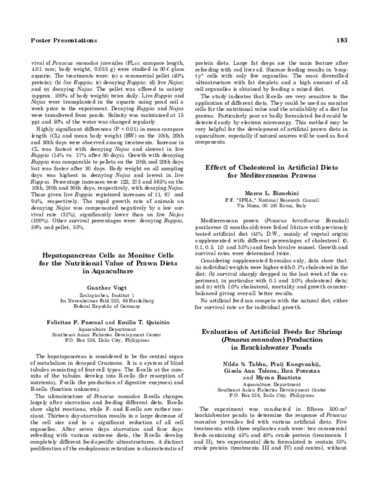Hepatopancreas cells as monitor cells for the nutritional value of prawn diets in aquaculture
- Global styles
- MLA
- Vancouver
- Elsevier - Harvard
- APA
- Help

Date
1985Page views
4,451ASFA keyword
AGROVOC keyword
Taxonomic term
Metadata
Show full item record
Share
Abstract
The hepatopancreas is considered to be the central organ of metabolism in decapod Crustacea. It is a system of blind tubules consisting of four cell types. The E-cells at the summits of the tubules develop into R-cells (for resorption of nutrients), F-cells (for production of digestive enzymes) and B-cells (function unknown).
The ultrastructure of Penaeus monodon R-cells changes largely after starvation and feeding different diets. B-cells show slight reactions, while F- and E-cells are rather constant. Thirteen day-starvation results in a large decrease of the cell size and in a significant reduction of all cell organelles. After seven days starvation and four days refeeding with various extreme diets, the R-cells develop completely different food-specific ultrastructures. A distinct proliferation of the endoplasmic reticulum is characteristic of protein diets. Large fat drops are the main feature after refeeding with cod liver oil. Sucrose feeding results in "empty" cells with only few organelles. The most diversified ultrastructure with fat droplets and a high amount of all cell organelles is obtained by feeding a mixed diet.
The study indicates that R-cells are very sensitive to the application of different diets. They could be used as monitor cells for the nutritional value and the availability of a diet for prawns. Particularly poor or badly formulated feed could be detected early by electron microscopy. This method may be very helpful for the development of artificial prawn diets in aquaculture, especially if natural sources will be used as food components.
Description
Abstract only.
Suggested Citation
Vogt, G., Pascual F. P., & Quinitio, E. T. (1985). Hepatopancreas cells as monitor cells for the nutritional value of prawn diets in aquaculture. In Taki Y., Primavera J.H. and Llobrera J.A. (Eds.). Proceedings of the First International Conference on the Culture of Penaeid Prawns/Shrimps, 4-7 December 1984, Iloilo City, Philippines (p. 183). Iloilo City, Philippines: Aquaculture Department, Southeast Asian Fisheries Development Center.
Type
Conference posterISBN
9718511008




